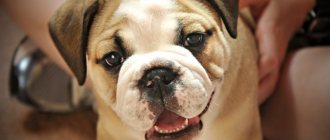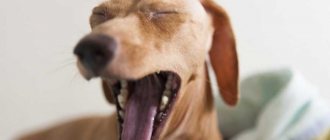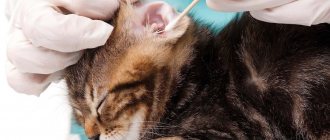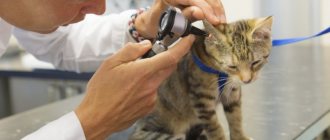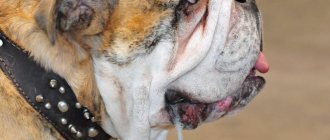Dog owners know that every pet requires proper care and attention. It is necessary to constantly monitor the state of his health and identify the causes of the symptoms that appear. The most common symptom is a foul odor coming from your dog's ears.
The causes of this unpleasant symptom may be: diseases of the ears themselves, general health problems, or simply improper care of your pet.
Odors in diseases
Veterinarians identify several different odors coming from dogs' ears that indicate various ailments. These include:
- Unpleasant odor : often caused by an accumulation of pus that has formed in the ear canal.
- The smell of dog, rotten meat : with insufficient care of individuals whose ear canal is original in its structure.
- Sour odor : for bacterial or yeast infections.
- The smell of fish or cottage cheese indicates digestive problems.
- Sulfur smell: common in breeds that have a predisposition to produce excessive sulfur. Examples are German Shepherds and Dutchhounds.
- Sweetish, honey and apple smells : a manifestation of liver disease.
- Cheesy or musty smell : A sign of a yeast infection.
- Mushroom odor : indicates the presence of fungus due to lack of proper care for the dog’s ears.
IMPORTANT . A specific disease is not always accompanied by only a specific odor. The smell can be almost anything. The presence of any odor is already a symptom.
Dog ear anatomy
A dog's ear canal consists of three parts: the outer, middle and inner ear . The outer ear - the part of the ear that we can see - is called foam and protects the inner parts of the ear, which house important structures that serve our dogs.
Important nerves and blood vessels also run through the inside of the ear and must be protected. Ear diseases can compromise these structures and cause permanent damage. This is why supporting your dog's ears is so important.
External manifestations
More accurately, the cause of ear odor can be determined by external signs. The main ones are the following:
- Squelches in the ear . With otitis media, pus accumulates, which, when pressed on the base of the ear, causes a characteristic squelching sound.
- Leaking from the ear . Also, a direct sign of otitis media is the leakage of sticky, odorous fluid from the auricle. It can be brown or white.
- Ichr . Ear mites, physical damage to the ear, or advanced otitis media cause bleeding.
- Discharge . Brown grains in the ear cavity are a sign of otitis media. If exudate is released from the ear, the color resembling coffee, then the pet is tormented by ear mites. Dark brown, smeared discharge in the ear indicates the formation of fungus and bacteria.
- Redness . It appears with any deviations from the norm. Inside the ear and outside.
- Peeling . The skin becomes dry and gradually begins to peel off. Perhaps the cause is an allergy.
- Itches . In most cases, diseases associated with the ears bring discomfort to the dog in the form of constant itching. Scabies is caused by insect bites, allergic reactions, fungus, and even dirt deposits.
- The dog shakes its ears . Constantly shaking the head or tilting the head to one side indicates otitis media. Also, the cause may be the same notorious ear mites or eczema.
Ear pain - how to determine it
The inside of the animal's ear is red and much hotter than the rest of the body. The dog shakes its head, tilts it towards the diseased organ, complains and whines. May also scratch it constantly, sometimes even until it bleeds. On the side of the diseased organ, the muscles are tense and painful on palpation.
- Discharge comes out of the ears, sometimes colorless; in advanced cases, it thickens and turns into pus.
- The dog’s behavior has changed - it is restless, aggressive, or, conversely, indifferent to everything, its appetite is reduced or absent. She may also experience insomnia.
- In all these cases, you should not self-medicate, but urgently contact a veterinarian.
Causes of ear diseases
There are many reasons for the development of ear diseases in dogs. Examples of some of them:
- injury caused by a bite or bruise of the hearing aid;
- allergies to food, treats or household chemicals;
- exposure to various parasites;
- getting a large amount of cold, dirty water into the ears;
- fungi or bacteria transmitted from other dogs;
- lack of vitamins in the pet’s body;
- tumor development;
- lack or excess of hormones;
- banal dirt getting into the ears.
It is worth mentioning the fact that during periods of high air humidity (autumn, spring), all dogs are especially susceptible to infectious diseases of the skin of the ears .
REFERENCE . Individual individuals at the genetic level may be susceptible to various ear diseases.
Therapy
Treatment will depend on the specific underlying cause. First, let's figure out what needs to be done in cases of allergic reactions. They are treated using antihistamines, foods containing a lot of polyunsaturated fatty acids (sea fish) are added to food, and the ears are regularly treated with antiseptic solutions. Sometimes corticosteroids are needed.
Ear mites . A characteristic sign of their presence should be considered a dry, dark, crumbly coating, reminiscent of coffee grounds in appearance. To eliminate the problem, you will need any drops like Bars and sterile vegetable oil, with which you can carefully remove the crusts. Below is a video instruction showing how to properly clean your pet's ears. If you ignore the basic rules, you can harm your dog, be careful!
Yeast. Causes extremely severe infections. The intensity of their development can be reduced by daily and thorough cleaning of the ears, as well as by prescribing special medications, since ordinary antibiotics do not kill them. Likewise, all types of infectious diseases.
Treatment
To provide more qualified assistance to your pet, you need to have a special first aid kit for the animal. Each dog owner determines the selection of medications needed for his pet, but there are standard medications for the treatment of ear diseases. It is recommended to always keep the following list of funds:
- gauze napkins;
- cotton swabs and disks;
- wet wipes for children;
- powder with antipruritic effect;
- specialized drops for dogs;
- ear lotion;
- camphor oil;
- ointment to eliminate inflammation.
Independent
Armed with this set of tools, you can begin treatment.
If the cause of the animal's illness and anxiety is dirt, it is necessary to carefully and thoroughly clean the ear cavity with a cotton pad soaked in a special lotion.
It is important to carry out this procedure several times a day. The same is the case with infection. Yeast and bacteria at an early stage of infection can be removed with cotton swabs and special drops.
In the case of the consequences of an allergic reaction, it is first necessary to identify the cause. Adjust your diet and instill antiallergic drops twice a day.
If the root cause of the disease is a tick, it is necessary to treat the ears with camphor oil and instill “Bars” drops.
IMPORTANT. A diseased organ requires proper, daily care. Even if the dog's ear is completely healthy on the outside, it is recommended to continue the procedures to avoid relapse.
Diagnostics and assistance from a veterinarian
There are often cases when the dog owner himself is unable to help his pet. This may be an acute, purulent otitis media or an allergic reaction that is too strong. Cases of neglected treatment or serious injury also require the intervention of a qualified specialist. He will be able to quickly and correctly diagnose and prescribe treatment, leading the animal to a speedy recovery without harmful consequences for the body.
When diagnosing, the first step is an external examination of the organ and a detailed examination of the skin. This is done using an otoscope. An experienced veterinarian will definitely find out the details of the occurrence of symptoms and ask about the pet’s food intake and lifestyle. If necessary, blood tests will be taken, x-rays and other required procedures will be performed.
How to get rid of odor from a dog's ears
Treatment is prescribed after identifying a disease that causes a strong odor:
- For infection. Typically, the basis of therapy is antibiotics that inhibit pathogenic bacteria. For fungal infections, antifungal drugs are prescribed. Products based on miconazole and ketanozole are effective. Also, for infection of any nature, Oricin and Nitrofungin are used.
- For allergies. Drug treatment will be effective only after diagnosis and identification of the allergen. Therapy is necessarily combined with excluding it from the diet, if it is a product, or eliminating contact with the irritant. A popular medicine is Otodepine, it is ear drops that have anti-edematous, antipruritic, and anti-inflammatory effects. Its analogues are Bars, Triderm.
Sometimes allergies are permanent. Then, during an exacerbation, drugs such as Nystatin, Suprastin are prescribed; they can be used daily or when a new rash appears in the ears.
- With otodectosis. Medicines are prescribed whose active substance has a detrimental effect on the tick. Cyfluthrin, Pyriproxyfen, Fipronil are effective.
- If a foreign body enters. After its removal, for which you often have to contact a veterinarian, healing agents are prescribed. To treat the wound, use Hydrogen Peroxide, then apply Ranosan, Saphroderm, and other ointments.
With purulent otitis media and some other diseases accompanied by peeling, it becomes necessary to remove the crusts. For this, softening solutions are used, for example, Otoferonol, which is used to treat the ear before the removal procedure.
Prevention
The best treatment is disease prevention. It is necessary to inspect the dog's ears daily, and once a week to clean them. Avoid exposure to water when swimming. Rinse the ear canal with a special lotion. For dogs with long hair, carefully trim the hair inside the ear flap. Try not to let your pet tumble on the damp ground.
ATTENTION. After walking in nature, you need to pay special attention to the inner surface of your ears. Make sure there are no nicks, scratches or foreign bodies on the skin of the ear.
Puppyhood and adolescence of the pet
These periods are characterized by rapid growth, increased metabolism and the intensity of the work of all glands. A lot of sulfur accumulates in the ear canal, and if it is not removed in time, a not very pleasant odor appears. It's easy to get rid of it:
- Check the condition of your ears often (at least 3-4 times a month).
- Clean with a cotton pad soaked (damp, but not wet!) with a weak saline solution or pharmaceutical saline solution.
- If wax has accumulated deeply, do not try to remove it with an ear stick. Place a few drops of hydrogen peroxide into the ear canal, rub the ear a few times clockwise, and remove any leakage from the ear with a cotton pad.
By following these simple recommendations, you can clean your animal’s ears without much difficulty. As a last resort, you can always go to the veterinarian and entrust this procedure to a professional.
Fungal and bacterial infections
More common in long-eared breeds. Prerequisites for the disease may include water entering the ear canal, untreated inflammation of the middle ear, injury, and failure to comply with basic hygiene rules. Long ears block access to the sun's rays, which can cope with infection in the initial stage of the disease. Dogs, experiencing discomfort, scratch their ears and behind the ears, opening the way to additional infection. Signs of pathology:
- discharge from the ear canal of a brownish liquid with a sugary sour-sweet odor;
- scratching behind the ears;
- twitching ears and tilted head;
- in advanced cases – painful sensations.
The condition requires immediate contact with a veterinary clinic and serious treatment of your four-legged friend. Lack of medical care can lead to acute inflammation and hearing loss.
Hematomas and tumors
Swelling on the ear or on the head near it can be the result of bruises, animal or insect bites, and sometimes - a manifestation of a separate disease. The dog becomes restless, tries to scratch the lump with its paw, and walks with its head tilted to the floor.
If you are sure of the origin of the pathology, try to help yourself: wash the abrasion (if there is one), treat the auricle with a special lotion (sold at a veterinary pharmacy), apply a thin layer of the veterinary drug Mastisan. The instructions do not say anything about dogs, but it relieves inflammation very well and usually does not cause allergies.
A doctor's help will be needed if the owner does not know what caused the lump. The dog needs to be examined. Surgery may be needed.
